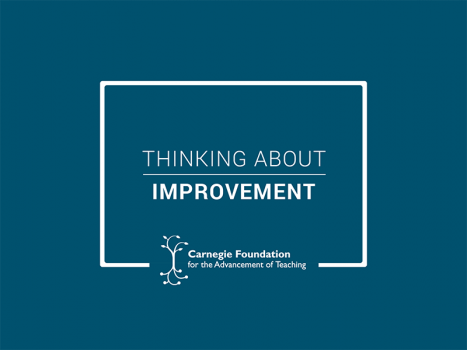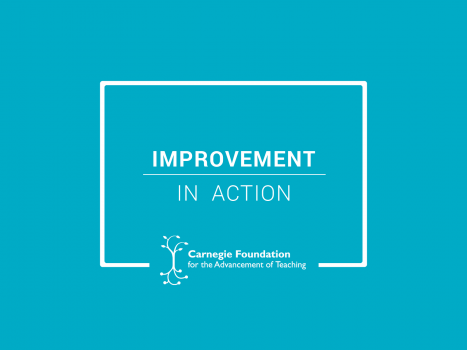Editor’s note: Untangling complex problems in education requires a more sophisticated solution than slicing through a Gordian knot; it takes a community committed to seeking answers, but not just any community, as we explain in this summary of an article from the November 2016 issue of the Kappan, written by Carnegie Foundation scholars Louis M. Gomez, Jennifer L. Russell, Anthony S. Bryk, Paul G. LeMahieu, and Eva M. Mejia.
There’s a problem plaguing your district and you’ve decided to create a network to figure out what’s not working and how to fix it. You bring together a group of teachers, administrators, and parents. They talk, they share ideas, they propose solutions, and they leave. You’re invigorated by the conversation. Now what? What type of network should they form? System-wide problems, the type usually confronting education, are big and multi-faceted. They require a community working together. Sometimes, all you need is network members to just share their thoughts, not to participate in finding a solution. Other times you need network members to band together and address the problem as one.
The idea of forming collective action networks is gaining a lot of traction as educators realize that no one person alone can solve a problem that has its roots in a complex system. A lone classroom teacher can’t improve 3rd grade literacy rates for their school (much less for the district), nor can a department chair single-handedly increase the number of community college students passing developmental math. Pressing educational problems require input from experts in a variety of disciplines and professional roles — researchers, teachers, faculty members, and education leaders. Still, not all networks are built the same, and simply bringing together diverse voices is no guarantee of success. The questions to ask are: “What kind of network do you need? Can your problem be solved with a sharing network or does it need the commitment of an execution network?”
A Network for Tame or Wicked Problems
Broadly speaking, the best network for your needs depends, in part, on whether you’re dealing with a tame problem or a wicked problem. The terms refer to the process, not to the nature of the problem. Wicked problems have many possible solutions, none of which is clear at the beginning, while tame problems have a well-known process to get from start to finish. That doesn’t mean that tame problems are simple or easy. They may require many steps, involve some technological innovation, or take a long time to resolve. They’re referred to as tame because the nature of the solution is known at the start. A tame problem is one that can be solved by selecting and appropriately applying the correct algorithm.
Sharing networks are more suited to tame problems and are organized to help individuals improve. Execution networks operate more like professional scientific communities in which participants bring their expertise to bear to solve large-scale, multi-faceted problems.
“In a community whose overarching goal is sharing information, the coordination bar is set lower than in a community whose purpose is common action to achieve measureable improvements on a problem,” explain the authors of the Kappan article.
In the article, Carnegie colleagues cite the Math Forum as an example of a sharing network focused on a tame problem. Gene Klotz, professor emeritus of Swarthmore College, founded the forum in 1992, as a place for mathematics educators to discuss and share ideas for implementing problem- and project-centered teaching instead of traditional memorization and drill-and-kill practices. The Math Forum met the conditions and commitments of a sharing network: a visionary leader with a compelling idea to address a problem — in this case, a lack of access among teachers to rich math problems and practical knowledge regarding a very different method of teaching — and an audience willing to participate in that level of sharing and learning.
Wicked problems don’t have such obvious solutions. They require a deeper commitment to participate as a community that coordinates its actions and adheres to at least these four defining characteristics:
- Focused on a well-specified common aim, such as reducing the failure rate in developmental math
- Guided by a deep understanding of the problem, the system that produces it, and a shared working theory of how to improve it
- Disciplined by the methods of improvement science to develop, test, and refine interventions
- Organized to efficiently implement and support the interventions in the field — in classrooms, schools, districts, and colleges.
The Mathematics Teacher Education Partnership (MTE-Partnership) is an example of one such networked improvement community. It grew out of a sharing network started by W. Gary Martin, a leader in the mathematics education community, and Howard Gobstein, an executive vice president at the American Association of Public and Land-Grant Universities (APLU). It addresses the problem of the shortage of secondary school math teachers who are adequately prepared to teach to the more demanding new mathematics standards.
“Collective action starts to take hold when diverse actors stop viewing a problem as someone else’s problem to worry about.”
In 2012, after learning about networked improvement communities, Martin and Gobstein decided to transform their initial community into a NIC. They thought this was doable because members had instinctively taken on characteristics of a NIC; they were working collaboratively to identify and agree on the key problem areas in secondary school math instruction as well as their preparation for service as instructional professionals.
Martin and Gobstein created an even sharper focus on the issue by forming smaller subgroups within the NIC, which they called research action clusters (RACs). Each RAC was charged with addressing a specific sub-problem, such as exploring new teaching methods in college to increase the number of students enrolling and succeeding in STEM courses. Today, the MTE-Partnership has grown to include more than 100 universities and colleges and 142 K-12 school districts in 30 states. The entirety of this NIC is working to improve teacher preparation programs to equip new teachers to engage in the more ambitious teaching envisioned in the new math standards. Work like this is does not have a single well-defined solution or an absolutely clears set of steps from beginning to the end. The MTE-Partnership community, like all others addressing wicked problems, will have to learn its way to sustainable solutions.
It hasn’t been all smooth sailing. Members of the new NIC had to learn how to move from sharing ideas to being committed to achieving a common aim. That’s a fundamental distinction between a sharing network and an execution network. As the authors describe it, “Collective action starts to take hold when diverse actors stop viewing a problem as someone else’s problem to worry about.” Instead, they agree to a set of principles that include contributing ideas based on their expertise; seeing the problem as a collective, complex responsibility; and committing to work collaboratively within a formal, disciplined structure to solve it.
November 14, 2016
Policy can do a lot to support positive changes, but policy alone isn’t effective in such large, diverse, and complex arenas as education, wrote policy analyst Paul Lingenfelter in comments solicited by the federal Commission on Evidence-Based Policymaking.
December 8, 2016
Teachers at High Tech High, a network of charter schools in San Diego County, say using improvement science has cultivated collaboration; set guidelines for clear, measureable goals; fostered innovative ideas; and encouraged more teachers to start improvement networks.







